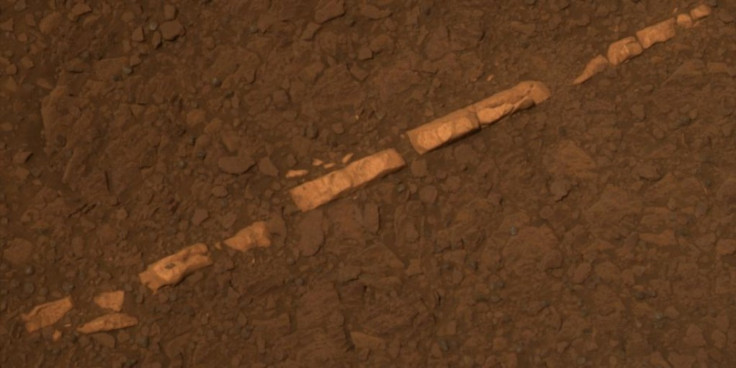Water on Mars: NASA Probe Finds Proof of Ancient Flow
Water is Thought to be the Primary Ingredient for Life to Have Existed on Mars

A sliver of mineral deposits left over from ancient water flows has been discovered on Mars by NASA's Mars Exploration Rover Opportunity, researchers said Dec. 7. The bright vein of mineral appears to be gypsum and is about an inch wide by 18-inches long.
"This tells a slam-dunk story that water flowed through underground fractures in the rock," Steve Squyres of Cornell University, principal investigator for Opportunity told the American Geophysical Union's conference in San Francisco.
"This stuff is a fairly pure chemical deposit that formed in place right where we see it. That can't be said for other gypsum seen on Mars or for other water-related minerals Opportunity has found. It's not uncommon on Earth, but on Mars, it's the kind of thing that makes geologists jump out of their chairs."
The deposit was found near the rim of a crater known as Endeavour. Opportunity has traveled nearly 20 miles around the Martian surface in its nearly eight years there, and hasn't seen anything like this before.
In November, scientists used a tool called the Microscopic Imager and Alpha Particle X-ray Spectrometer on Opportunity's arm to inspect the vein now jauntily called Homestake. The spectrometer picked up levels of calcium and sulfur in quantities pointing to a compound called calcium sulfate. Depending on how much water has been present determines what form the crystalline structure will take, and the vein indeed shows hydrated calcium sulfate. That compound is also known as gypsum, used here for making drywall and occurring naturally in places like the White Sands National Monument in New Mexico. Gypsum has been found on Mars before, but only in one place, and not in the same form.
"It is a mystery where the gypsum sand on northern Mars comes from," Opportunity science-team member Benton Clark of the Space Science Institute in Boulder, Colo. said in a statement.
"At Homestake, we see the mineral right where it formed. It will be important to see if there are deposits like this in other areas of Mars."
The Homestake deposit, whether gypsum or another form of calcium sulfate, likely formed from water dissolving calcium out of volcanic rocks.
Throughout Opportunity's long journey across Mars' Meridiani plain, the rover has driven over bedrock composed of magnesium, iron and calcium sulfate minerals that also indicate a wet environment billions of years ago. The highly concentrated calcium sulfate at Homestake could have been produced in conditions more neutral than the harshly acidic conditions indicated by the other sulfate deposits observed by Opportunity.
"It could have formed in a different type of water environment, one more hospitable for a larger variety of living organisms," Clark said.
Opportunity and its rover twin, Spirit, completed their three-month prime missions on Mars in April 2004. Both rovers continued for years of extended missions and made important discoveries about wet environments on ancient Mars that may have been favorable for supporting microbial life. Spirit stopped communicating in 2010. Opportunity continues exploring, currently heading to a sun-facing slope on the northern end of the Endeavour rim fragment called "Cape York" to keep its solar panels at a favorable angle during the mission's fifth Martian winter. NASA launched the next-generation Mars rover, the car-sized Curiosity, on Nov. 26. It is slated for arrival at the planet's Gale Crater in August 2012.
© Copyright IBTimes 2024. All rights reserved.




















